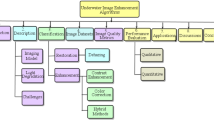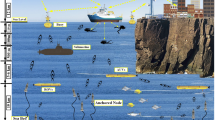Abstract
Due to the low sound propagation speed, the tradeoff between high azimuth resolution and wide imaging swath has severely limited the application of sonar underwater target imaging. However, based on compressed sensing (CS) technique, it is feasible to image targets with merely one pulse and thus avoid the above tradeoff. To investigate the possible waveforms for CS-based underwater imaging, the deterministic M sequences widely used in sonar applications are introduced in this paper. By analyzing the compressive matrix constructed from M sequences, the coherence parameter and the restricted isometry property (RIP) of the matrix are derived. Also, the feasibility and advances of M sequence are demonstrated by being compared with the existing Alltop sequence in underwater CS imaging framework. Finally, the results of numerical simulations and a real experiment are provided to reveal the effectiveness of the proposed signal.
Similar content being viewed by others
References
Gilmour G A. Synthetic Aperture Side-Looking Sonar System. U.S. Patent 4088978, May 1978
Griffiths H D. Synthetic aperture imaging with sonar and radar: a comparison. In: Proceedings of the 5th World Congress on Ultrasonics, Paris, 2003. 511–518
Hayes P, Gough T. Synthetic aperture sonar: a review of current status. IEEE J Oceanic Eng, 2009, 34: 207–224
Franceschetti G, Lanari R. Synthetic Aperture Radar Processing. Boca Raton: CRC Press, 1999
Cutrona L J. Comparison of sonar system performance achievable using synthetic aperture techniques with the performance achievable with more conventional means. J Acoust Soc America, 1975, 58: 336–348
Cutrona L J. Additional characteristics of synthetic-aperture sonar systems and a further comparison with nonsynthetic-aperture sonar systems. J Acoust Soc America, 1977, 61: 1213–1217
Yu M, Xu J, Peng Y. Joint Doppler parameters estimation for squint-looking SAR. IET Radar Sonar Nav, 2007, 1: 207–212
Sutton T J, Griffiths H D, Hetet A, et al. Experimental validation of algorithms for high-resolution imaging of the seabed using synthetic aperture sonar. IET Radar Sonar Nav, 2003, 150: 78–83
Donoho D. Compressed sensing. IEEE Trans Inf Theory, 2006, 52: 1289–1306
Candes E, Romberg J, Tao T. Robust uncertainty principles: exact signal reconstruction from highly incomplete frequency information. IEEE Trans Inf Theory, 2006, 52: 489–509
Eldar Y, Kutyniok G. Compressed Sensing: Theory and Applications. New York: Cambridge University Press, 2012
Yan H C, Xu J, Xia X-G, et al. Wideband underwater sonar imaging via compressed sensing with scaling effect compensation. Sci China Inf Sci, 2015, 58: 020306
Baraniuk R, Steeghs P. Compressive radar imaging. In: Proceedings of IEEE Radar Conference, Boston, 2007. 128–133
Alonso T, Lòpez-Dekker P, Mallorqui J. A novel strategy for radar imaging based on compressive sensing. IEEE Trans Geosci Rem Sens, 2010, 48: 4285–4295
Yan H, Xu J, Peng S, et al. A compressed sensing method for a wider swath in synthetic aperture imaging. In: Proceedings of IET International Radar Conference, Xi’an, 2013. 1–6
Patel V M, Easley G R, Healy D M, et al. Compressed synthetic aperture radar. IEEE J Sel Top Signal Process, 2010, 4: 244–254
Zhu X, Bamler R. Tomographic SAR inversion by L1-norm regularization–the compressive sensing approach. IEEE Trans Geosci Rem Sens, 2010, 48: 3839–3846
Gurbuz A, McClellan J, Scott W. A compressive sensing data acquisition and imaging method for stepped frequency GPRs. IEEE Trans Signal Process, 2009, 57: 2640–2650
Li G, Burkholder R J. Hybrid matching pursuit for distributed through-wall radar imaging. IEEE Trans Antennas Propag, 2015, 63: 1701–1711
Li G, Varshney P K. Micro-Doppler parameter estimation via parametric sparse representation and pruned orthogonal matching pursuit. IEEE J Sel Top in Appl Earth Observ and Rem Sens, 2014, 7: 4937–4948
Herman M, Strohmer T. High-resolution radar via compressed sensing. IEEE Trans Signal Process, 2009, 57: 2275–2284
Baraniuk R, Davenport M, De Vore R, et al. A simple proof of the restricted isometry property for random matrices. Constr Approx, 2008, 28: 253–263
Mendelson S, Pajor A, Tomczak-Jaegermann N. Uniform uncertainty principle for Bernoulli and subgaussian ensembles. Constr Approx, 2008, 28: 277–289
Tropp J A, Wakin MB, DuarteM F, et al. Random filters for compressive sampling and reconstruction. In: Proceedings of the IEEE International Conference on Acoustics Speech and Signal Processing (ICASSP), Toulouse, 2006. 14–19
Rauhut H, Romberg J, Tropp J. Restricted isometries for partial random circulant matrices. Appli Comput Harmon Anal, 2012, 32: 242–254
Xu J, Pi Y, Cao Z. Optimized projection matrix for compressive sensing. EURASIP J Advances in Signal Process, 2010, 43: 1–8
Cleju N. Optimized projections for compressed sensing via rank-constrained nearest correlation matrix. Appli Comput Harmon Anal, 2014, 36: 495–507
Tropp J. Greed is good: algorithmic results for sparse approximation. IEEE Trans Inf Theory, 2004, 50: 2231–2242
Donoho D, Elad M. On the stability of the basis pursuit in the presence of noise. EURASIP Signal Process J, 2006, 86: 511–532
Li K, Gan L, Ling C. Convolutional compressed sensing using deterministic sequences. IEEE Trans Signal Process, 2013, 61: 740–752
Welch L. Lower bounds on the maximum cross correlation of signals. IEEE Trans Inf Theory, 1974, 20: 397–399
Dinan E, Jabbari B. Spreading codes for direct sequence CDMA and wideband CDMA cellular networks. IEEE Commun Mag, 1998, 36: 48–54
Author information
Authors and Affiliations
Corresponding author
Rights and permissions
About this article
Cite this article
Yan, H., Xu, J., Xia, XG. et al. Underwater sonar target imaging via compressed sensing with M sequences. Sci. China Inf. Sci. 59, 122308 (2016). https://doi.org/10.1007/s11432-016-5585-x
Received:
Accepted:
Published:
DOI: https://doi.org/10.1007/s11432-016-5585-x




